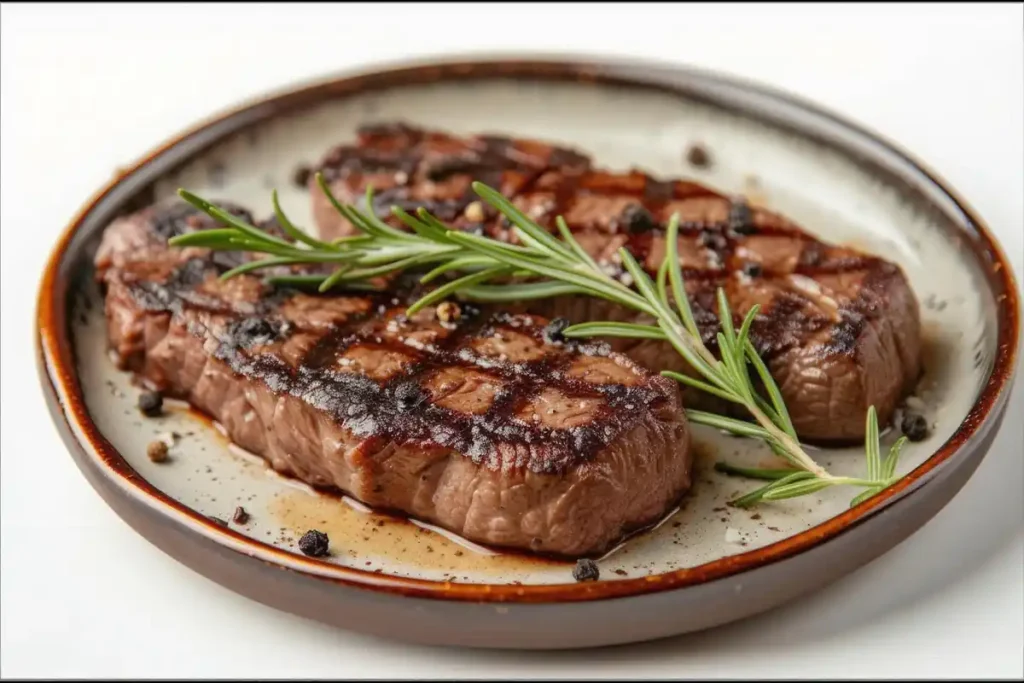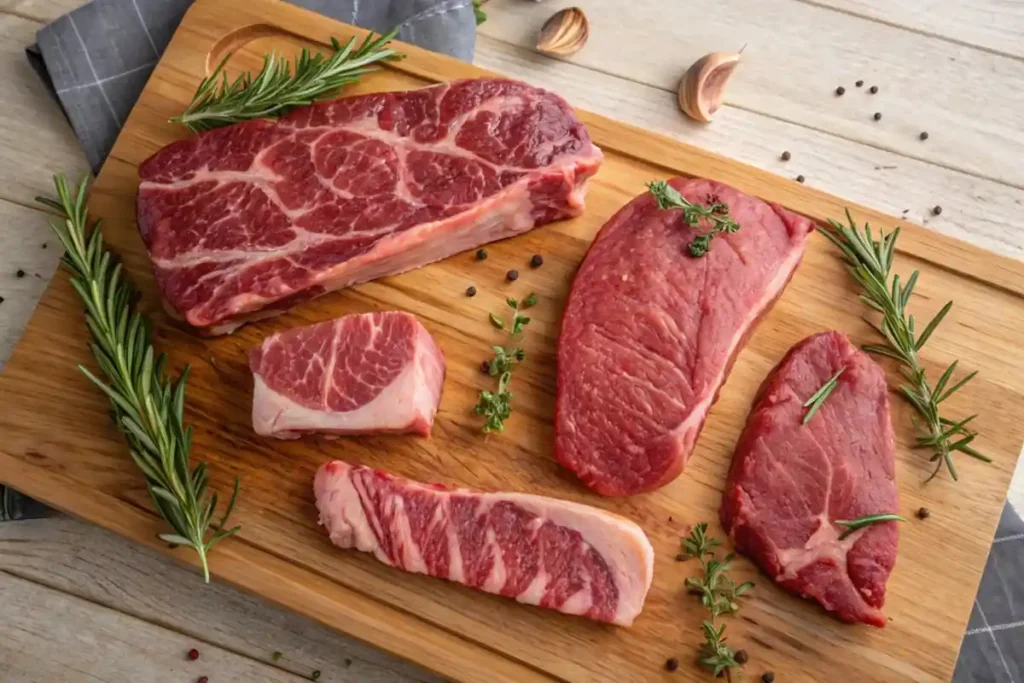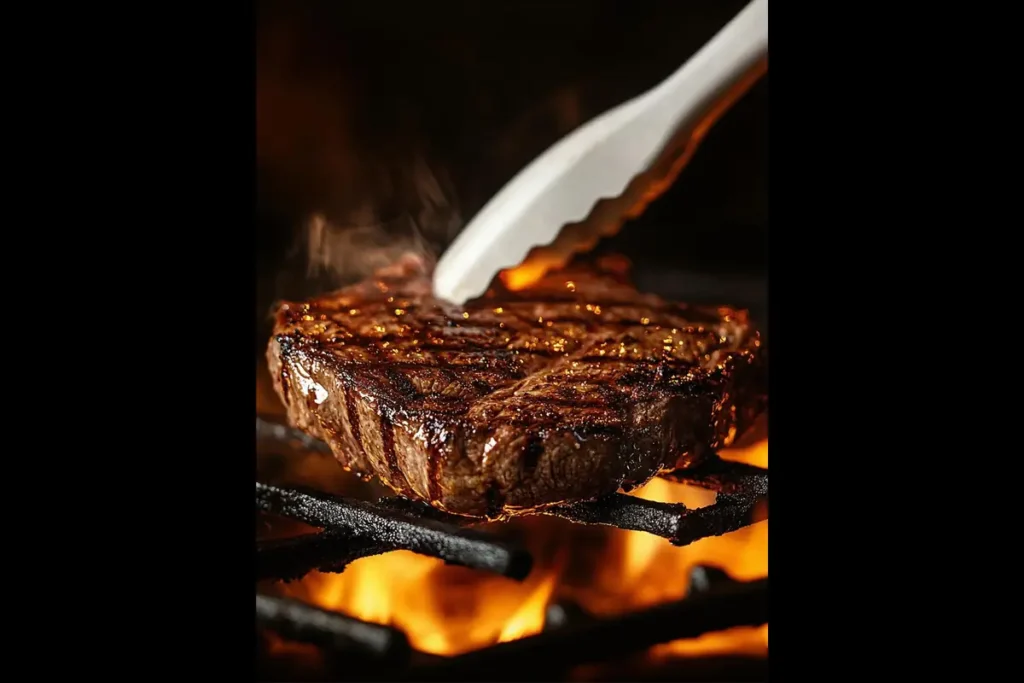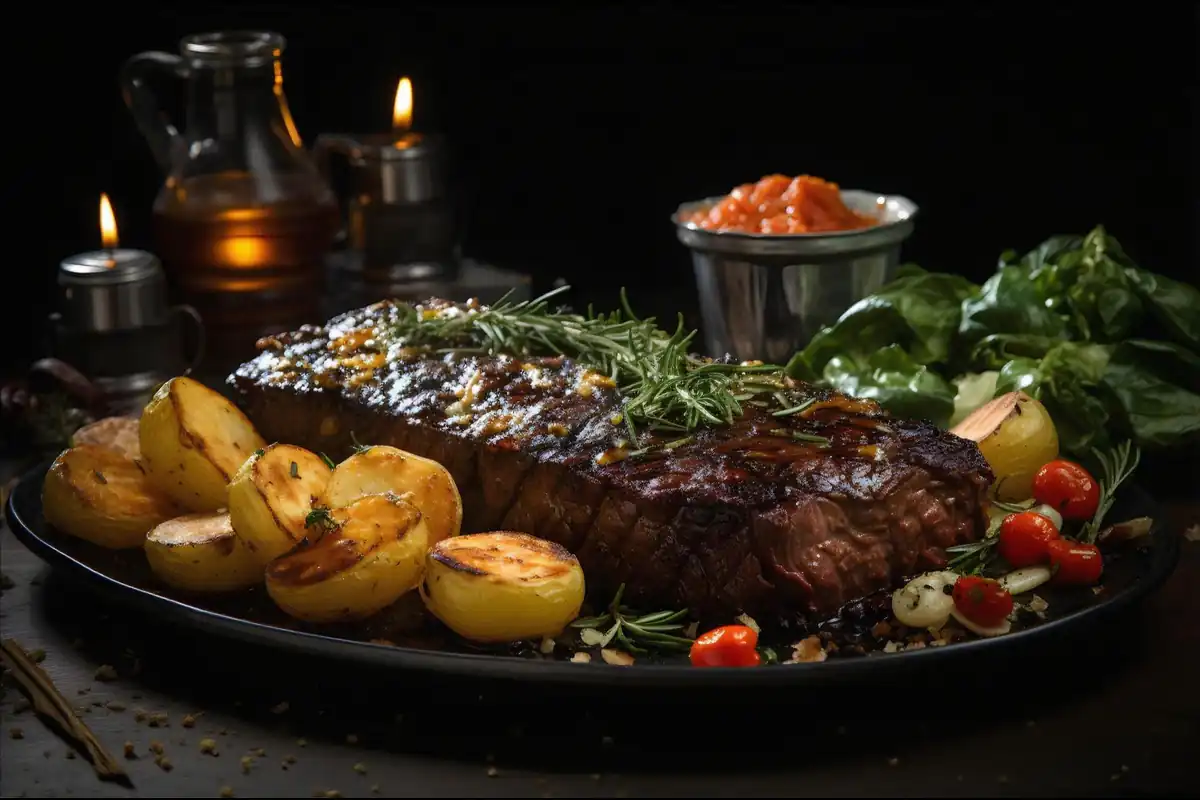Dive into the origins, flavor, and cooking tips of Delmonico steaks, plus compare them with other prime cuts for the perfect indulgent meal.
Introduction
Is Delmonico a good cut of steak? This question has been asked for generations by steak enthusiasts and home cooks who want to explore one of America’s most iconic beef offerings. The Delmonico steak holds a legendary status, but there is often confusion regarding its exact cut. Some butchers say it’s a ribeye, others call it a New York strip, and a few identify it as a top loin or even a portion from the chuck.
However, the essence of the Delmonico lies not just in the specific part of the animal but in its rich tradition and notable flavor. This steak gained fame at the historic Delmonico’s Restaurant in New York City, where it was synonymous with luxury and the pinnacle of fine dining. Over the years, multiple restaurants and meat purveyors have adopted the “Delmonico” label for several premium cuts, resulting in a lively debate about what truly defines this steak.
In this comprehensive guide, we will dive deeply into the origins of the Delmonico steak, its various definitions, taste, cooking methods, nutritional profile, and how it compares with other renowned cuts. Therefore, by the end of this article, you will have a thorough understanding of whether Delmonico is indeed a good cut of steak for your next meal. In addition, you will find cooking tips, recipe ideas, and frequently asked questions to address all your curiosities. Let’s get started!
Table of Contents
The History and Background of the Delmonico Steak
The Origins at Delmonico’s Restaurant
Delmonico’s Restaurant, founded in New York City in the early 19th century, transformed the American dining landscape. At a time when high-end cuisine was rare in the United States, Delmonico’s introduced dishes that would become culinary landmarks. The Delmonico steak was one such luxury item on its menu.
Originally, the Delmonico steak was reputed to be a sizable, tender piece of beef served with lavish accompaniments. However, records from that period are somewhat unclear, leading to ongoing debates about precisely which cut was used. In fact, the Delmonico steak soared in popularity because it was consistently high-quality and offered a mouthwatering experience—words like “rich,” “juicy,” and “marbled” were commonly used to describe it.
Over time, the Delmonico steak became synonymous with extravagance. Diners sought it out for special occasions, and the cut cemented its place in American culinary history. Today, the term “Delmonico” remains well-known, though its exact definition continues to evolve.
Emergence of Various Definitions
Despite the original connection to Delmonico’s Restaurant, the definition of the Delmonico steak is not set in stone. After the restaurant’s success, butchers and steakhouses across the country began labeling different cuts as “Delmonico.” This shift happened partly because Delmonico’s itself did not strictly define the cut in a way that was replicated by others. Therefore, many chefs emulated its signature style, and any large, high-quality steak might receive the Delmonico name.
For example, in some regions, a Delmonico is nothing more than a boneless ribeye, while in other places, it’s a bone-in rib steak or a steak cut from the top loin. Moreover, marketing played a big role as well—restaurants and grocery stores often use the Delmonico name to suggest premium quality. Consequently, when you see Delmonico steak at your local butcher’s shop, it is always wise to ask which specific part of the beef you’re getting.
The Delmonico Cut Debate: A Definition

Different Cuts Referred to as Delmonico
The absence of a universal definition lies at the heart of the Delmonico confusion. Even though its historical origin points to a premium steak with exceptional marbling and flavor, modern usage varies widely:
- Boneless Ribeye: This is probably the most common interpretation. Ribeye steaks are known for their generous marbling and bold flavor, which aligns well with the Delmonico’s reputation.
- Top Loin Steak: Some butchers refer to top loin steaks (often sold as strip steaks) as Delmonicos. Although they are generally leaner than ribeyes, top loin steaks still offer robust flavor and tenderness when prepared well.
- Bone-In Cuts: A minority of sources maintain that an authentic Delmonico should have a bone, claiming it enhances taste and presentation.
Because of these divergent opinions, it’s essential to clarify what you’re purchasing. Nevertheless, despite the confusion, nearly all versions deliver a reliably tender and flavorful experience, assuming you start with high-quality beef.
Why It’s Sometimes Confused with Ribeye or New York Strip
The most common question is: Is a Delmonico steak just a ribeye? The short answer is that it can be. Many Delmonico-labeled steaks are indeed ribeyes, which are prized for their abundant marbling and rich flavor. However, some butchers or steakhouses may instead use New York strips, which are slightly leaner but still considered a high-grade cut.
The confusion stems from marketing strategies. For instance, calling a piece of beef “Delmonico” can spark customer interest based on the name’s storied past. Nevertheless, from the consumer standpoint, it’s crucial to know whether you’re buying a ribeye or a strip. Therefore, you should always ask for specifics if you desire a particular flavor profile or cooking characteristic.
Flavor Profile and Texture of Delmonico Steak

Marbling, Fat Content, and Taste
Marbling refers to the flecks of fat interspersed within the muscle. A cut with a good amount of marbling will typically be more flavorful, as fat contributes to the steak’s juiciness and richness. Therefore, when people describe the Delmonico steak as “buttery” or “velvety,” they are usually referencing those luscious ribbons of fat that melt during cooking.
A Delmonico steak, particularly one cut from the rib section, often has considerable marbling. This results in a pronounced beefy taste that carnivores love. Additionally, if the steak is USDA Prime or high-end Choice, the flavor can be exceptionally bold. Thus, those who seek a full-bodied, succulent steak often gravitate toward Delmonico.
Tenderness and Cooking Considerations
Tenderness depends on how the meat is aged, the exact region it is cut from, and the cooking method. Generally, a Delmonico steak is quite tender—especially if it’s from the rib primal. However, if the cut is from the chuck or is a portion of a top loin, there might be slight variations in texture.
Nonetheless, proper cooking technique can preserve or even enhance tenderness. Most experts recommend cooking Delmonico steaks with high-heat methods such as grilling or broiling, which help sear in the juices. In addition, allowing the steak to rest after cooking ensures that the moisture redistributes throughout the meat, avoiding dryness.
How Delmonico Stacks Up Against Other Popular Cuts
Delmonico vs. Ribeye
For many, “Delmonico” and “ribeye” are practically synonymous, especially if you’re referring to the boneless version. Ribeyes are cherished for their intense marbling and buttery flavor. Likewise, Delmonico steaks are lauded for similar qualities. Therefore, if your butcher calls a boneless ribeye a Delmonico, you can expect an incredibly tasty, well-marbled steak.
However, some ribeyes come with the bone attached, while Delmonico steaks are typically served boneless—although exceptions exist. Thus, if you prefer a steak with a bone for added flavor, ribeye might be your choice. On the other hand, if you want an equally rich steak without a bone, a Delmonico labeled cut may be ideal.
Delmonico vs. New York Strip
A New York strip (sometimes called a strip loin or Kansas City strip) typically has less marbling than a ribeye but still provides significant flavor. Because Delmonico can sometimes be top loin, you could be purchasing something quite similar to a New York strip. However, New York strips are usually leaner and might not have the same melt-in-your-mouth quality as a heavily marbled Delmonico.
Nonetheless, strip steaks have a firmer bite, which appeals to those who want a big steak flavor without the extra fattiness of a ribeye. If your idea of a great steak is a balance of moderate marbling, tender texture, and bold flavor, a strip could be your go-to. Consequently, if your Delmonico is a top loin steak, it will behave similarly to a strip in both taste and texture.
Delmonico vs. Filet Mignon
Filet mignon is one of the tenderest cuts available, owing to its low-fat content and unique muscle fibers. But with that tenderness often comes a trade-off: less marbling and, therefore, less intense beef flavor. By contrast, a Delmonico steak is generally much richer and fattier. If you love the buttery mouthfeel that comes from succulent beef fat, Delmonico is the superior choice.
However, for those who prioritize supreme tenderness above all, filet mignon remains the leader. For example, in a formal dinner setting, the tenderness of filet might be what you want. In contrast, if you crave a bold, savory taste, Delmonico (particularly if it’s a ribeye-like cut) wins hands down.
Nutritional Profile of Delmonico Steak
Macronutrients (per 100g)
When discussing whether Delmonico is a good cut of steak, nutrition often comes into play. Portion size and frequency matter significantly in maintaining a healthy diet. Below is a general breakdown of the macronutrients you might expect from a 100g serving of Delmonico steak (assuming a ribeye-like cut).
| Nutrient | Approximate Amount |
|---|---|
| Calories | 255 kcal |
| Protein | 25 g |
| Total Fat | 17 g |
| Saturated Fat | 6–7 g |
| Carbs | 0 g |
Keep in mind that these values may vary based on the grade of beef and precise cut location. However, this table provides a helpful snapshot of what you’ll get in terms of calories, protein, and fat.
Micronutrients and Health Considerations
Beef is an excellent source of iron, zinc, and B vitamins such as B12 and niacin. Therefore, Delmonico steak can be a useful part of your diet, supplying essential nutrients that support immune function, muscle maintenance, and energy metabolism. Nevertheless, moderation is advisable due to the higher saturated fat content found in well-marbled cuts. Balancing your meal with vegetables or light sides can help create a nutritious plate.
Cooking Techniques and Best Practices
Selecting the Right Grade
When you see Delmonico steaks at your local market, you might have the option of USDA Prime, USDA Choice, or perhaps a lower grade. Prime-grade steaks have the most marbling and typically yield the most satisfying results. However, they also come with a higher price tag. Choice-grade Delmonico steaks can still be delicious if prepared properly, so your budget and taste preferences will guide your selection.
Preparation and Seasoning
For a great steak, simple seasoning often works best. Generously salt your Delmonico steak with kosher salt and a sprinkle of freshly ground black pepper. If you wish, you can add garlic powder or dried herbs like rosemary. Because these steaks are already flavorful, you do not need to overwhelm them with complex marinades. However, if you want a more adventurous flavor profile, a light marinade with olive oil, garlic, and herbs can be employed.
Let your steak sit at room temperature for about 30 minutes after seasoning. This step helps the meat cook more evenly and prevents a cold center. In addition, patting the steak dry before cooking encourages a beautifully seared crust.
Common Cooking Methods—Grilling, Broiling, and Pan-Searing
- Grilling: Preheat your grill to high heat. Sear each side of the steak for about 2–3 minutes to lock in juices. Then move the steak to indirect heat to finish cooking to your preferred doneness. For example, aim for 130°F (54°C) for medium-rare.
- Broiling: Set your oven’s broiler on high. Place the Delmonico steak on a broiler pan so the heat can circulate underneath. Broil each side for 4–6 minutes, monitoring closely to avoid overcooking or burning. This method replicates a restaurant-style salamander approach.
- Pan-Searing: Use a cast-iron skillet for the best heat retention. Preheat the skillet until it’s almost smoking, then add a small amount of cooking oil with a high smoke point (like avocado or canola). Place the steak in the pan and resist the urge to move it around. After 2–3 minutes, flip the steak. Sear the other side until it forms a beautiful crust. If needed, finish in the oven to reach your target internal temperature.
Resting and Serving Tips
After any cooking method, let your Delmonico steak rest on a cutting board for 5–10 minutes. Resting allows the internal juices to redistribute, ensuring each bite is succulent. Slice against the grain if the steak’s grain is visible—this technique helps maintain a tender texture. In addition, plating your steak with a side of steamed vegetables, a crisp salad, or a baked potato can round out the meal nicely.
Popular Delmonico Steak Recipe

Below is a detailed recipe for a Classic Grilled Delmonico Steak that is both simple and delicious:
Ingredients
- 1 Delmonico steak (about 1–1.5 inches thick)
- 1 tablespoon kosher salt
- 1 teaspoon freshly ground black pepper
- 1 teaspoon garlic powder (optional)
- 1 tablespoon olive oil
Step-by-Step Cooking Instructions
- Bring Steak to Room Temperature
- Remove your Delmonico steak from the fridge about 30 minutes before cooking. Pat it dry on both sides with paper towels.
- Season the Steak
- Drizzle olive oil on both sides of the steak and rub it in gently.
- Evenly sprinkle kosher salt, black pepper, and, if you like, a hint of garlic powder on both sides. Let the steak rest for a few minutes.
- Preheat the Grill
- Set your grill to high heat. Allow the grill grates to get hot for at least 10–15 minutes. High heat is essential for that perfect sear.
- Sear Over Direct Heat
- Place the steak directly over the high flame. Grill for about 2–3 minutes, then rotate 45 degrees (to get those beautiful cross-hatch marks). After another 2–3 minutes, flip the steak carefully.
- Finish Cooking
- Continue grilling the other side for an additional 4–6 minutes, adjusting time based on desired doneness. Use a meat thermometer to check internal temperature (130°F or 54°C for medium-rare).
- Rest the Steak
- Remove the steak from the grill and place it on a cutting board. Cover loosely with foil and let it rest for 5–10 minutes. This step is crucial for juicy results.
- Slice and Serve
- Cut the steak against the grain if needed, or serve it whole. Pair with your favorite sides such as steamed broccoli, roasted vegetables, or a hearty salad.
Where to Buy Delmonico Steak
Local Butchers vs. Supermarkets
Local butchers often provide a more personalized experience. They can tell you exactly which primal cut you are getting when you ask for a Delmonico steak. In addition, your butcher can trim, portion, or age the beef according to your preferences. Supermarkets, while convenient, might not always label cuts with accuracy or consistency, so be sure to read the label carefully or ask someone at the meat counter for help.
Online Retailers and Subscription Boxes
In this digital age, several reputable online meat retailers and subscription services deliver high-quality steaks right to your doorstep. These platforms frequently list the specific cut alongside the “Delmonico” label, clarifying whether it is a ribeye or top loin. Always look for companies with transparent sourcing and clear product descriptions.
Frequently Asked Questions
Is Delmonico better than ribeye?
Delmonico steak is often equated with ribeye because many Delmonico steaks are actually ribeyes. However, “Delmonico” can also be used for other cuts. If you’re specifically referring to a boneless ribeye labeled as Delmonico, then it’s essentially the same in terms of marbling and flavor. Therefore, it’s not necessarily “better,” but rather very similar, especially if it originates from the same part of the beef. In other words, they’re equally excellent, assuming you enjoy a rich, well-marbled steak.
Is Delmonico steak tough or tender?
A genuine Delmonico steak is usually tender due to its high marbling content, especially if it is truly a ribeye or top loin. Proper cooking methods—like quick, high-heat searing—also play a big role in tenderness. Therefore, when cooked to medium-rare or medium, Delmonico steaks often deliver a juicy, tender bite.
What is a Delmonico steak equivalent to?
Depending on the source, a Delmonico steak can be equivalent to a boneless ribeye, a bone-in rib steak, or a strip steak from the top loin. Nevertheless, most commonly, if you see Delmonico steak at a restaurant, you will likely receive a thick, boneless ribeye. Therefore, it pays to confirm with your server or butcher if you want a specific steak experience.
What is the number 1 cut of steak?
The “number 1” cut of steak can be subjective and depends largely on personal preference. Some people love the balanced flavor of the New York strip, while others swear by the melt-in-your-mouth tenderness of filet mignon. Many aficionados, however, rank the ribeye very high for its marbling and bold flavor profile. Thus, if your Delmonico is indeed a ribeye, you could argue it’s among the very best.
Conclusion
The term “Delmonico” has traveled a long way from its origins at a landmark New York restaurant. While this has led to multiple interpretations of what the Delmonico steak actually is, the core concept endures: a generous, well-marbled, delicious cut of beef that treats you to a memorable dining experience. Whether it’s a ribeye, a strip, or a bone-in cut, a Delmonico steak can be a fantastic choice for meat lovers who crave bold taste and tenderness.
Above all, knowing what you’re buying—and understanding how to cook it—ensures you’ll get the most out of your Delmonico steak. Therefore, do not hesitate to discuss specifics with your butcher or server. You can also explore other beefy topics such as the best meat for chili or compare your Delmonico to an in-depth look at Delmonico steak history, preparation & cooking. Whichever way you enjoy your next Delmonico, hopefully this guide has shed light on the age-old question: Is Delmonico a good cut of steak? The answer is a resounding “yes,” especially for those who appreciate a richly flavored, well-marbled indulgence.

